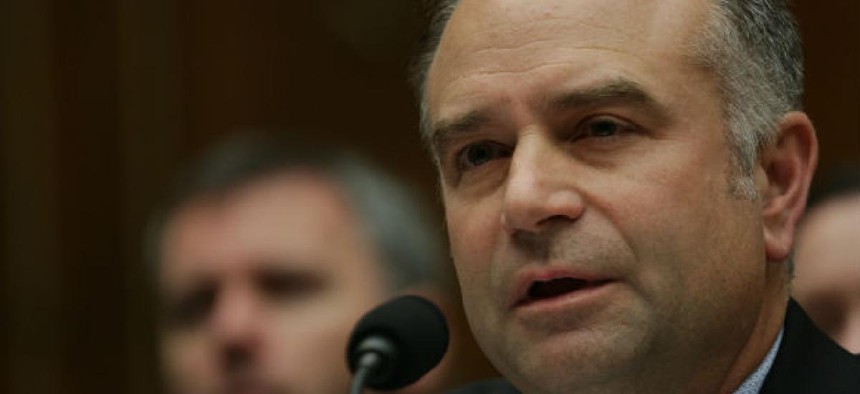Dave Powner audits the state of federal IT

The GAO director of information technology issues is leaving government after 16 years. On his way out the door, Dave Powner details how far govtech has come in the past two decades and flags the most critical issues he sees facing federal IT leaders.

After 16 years, Dave Powner is leaving the Government Accountability Office for a job with Mitre.
For 16 years, Dave Powner has served as one of one most visible overseers of good governance in federal IT. From his perch as director of information technology issues at the Government Accountability Office, Powner has helped track and guide federal agencies through a necessary and sometimes painful evolution into 21st century digital enterprises.
Now, with a presidential administration that has put modernization front and center and concerns over cybersecurity elevating tech issues in the minds of Congress, federal IT has never been more important or impactful. Yet Powner is choosing to walk away -- taking a job with Mitre as director of strategic engagement and partnerships, where he will work on “similar issues” from a new perspective outside of government.
“Sometimes you have an opportunity to do something different and you get excited about it,” he told FCW.
Looking back on his career, Powner cited as his proudest accomplishments the role he played establishing the IT dashboard (warts and all); helping to push through the Federal IT Acquisition and Reform Act; cataloguing and shrinking the government’s data center footprint; and strengthening CIO authorities. He also pointed to a more-general improvement in GAO's ability to track the operational and structural problems plaguing government -- a pivot from its traditional focus on acquisition issues.
Powner was complimentary of the way the Trump administration has emphasized and blended both modernization and cybersecurity, and said he believes the government is on track to dramatically improve in both areas – if federal leaders don’t take their eye off the ball.
“I think this administration has kind of put IT – with the Presidential Management Agenda and the modernization strategy and the American Tech Council and all that stuff -- at a more prominent level than some other administrations,” Powner said. “Now the question is – OK, It’s there, now are we going to do something about it? It’s always about the implementation.”
The unfinished business he’s leaving behind, however, will come as little surprise to the federal IT community. While CIOs are more empowered today than they were 16 years ago, nine of the 24 CFO Act agencies still don’t have direct reporting relationships between their CIO and secretary or administrator. The agency CIO position still has limited and uneven visibility or control over agency IT spending, something GAO auditors say leads to duplicative and poorly conceived IT contracts.
Laws like the Clinger-Cohen Act and FITARA, as well as a recent Executive Order signed by President Donald Trump, have attempted to codify the role that CIOs are supposed to play as primary stakeholders within agency leadership, but Powner believes more must be done to signal to top talent that the juice will be worth the squeeze.
“Folks come here from the private sector,” said Powner. “Who wants to be buried at some agency?”
Building up and maintaining the IT workforce remains a substantial challenge, both at the top layer and among rank-and-file feds. The federal workforce's thin bench of qualified IT employees, particularly engineers and architects with technical and coding skills, puts agencies at a disadvantage when overseeing contractors.
“Contractors come in with their technical folks, blow the government out of the water," Powner said. "You need to have some horsepower on your side to do the same.”
Another root cause of the government’s IT woes: The average tenure for a federal agency CIO ranges between 16 months and two years, something Powner said has a real impact on the government’s ability to tackle big tech problems and implement a long-term vision. He thinks Congress should consider legislation to make the position subject to a five-year appointment to encourage CIOs to focus more on the hard problems than the quick and easy ones.
“They come in, pick the low-hanging fruit, claim a few wins, put a strategy in place and then leave without effectively implementing the strategy,” he said. “Then someone else comes in, and you know what? It’s a new strategy.”
Powner’s work and influence over federal IT policy has received praise from tech-minded policymakers in both parties. Rep. Will Hurd (R-Texas), lead author of the Modernizing Government Technology Act, said Powner should go down in history for his role holding agencies accountable for the technologies they buy and use. Rep. Gerry Connolly (D-Va.), one of the lead authors of FITARA, credits Powner with using his audit power and congressional testimony to keep the pressure on IT leaders to implement the law effectively.
Filling that oversight role often involves conflict, and many times Powner’s job is to pour cold water on the overly positive narratives floated by agencies about the state of their systems and networks. He has modeled his approach on a simple mantra: The facts are the facts and people won’t respect you if you sugarcoat the depth of the problem.
“It’s kind of this blend where you can hit them hard when you need to, but be balanced [and] end on being constructive,” said Powner. “At the end of the day you want to walk away being constructive.”
NEXT STORY: GSA gets new head of services office


